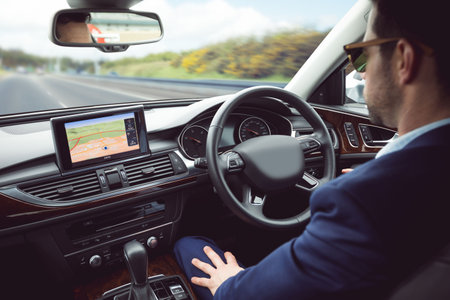1. Stay Focused and Avoid Distractions
New drivers should always keep their eyes on the road, avoid using mobile devices, and minimize distractions to maintain full awareness of their surroundings. Staying focused is one of the most important defensive driving skills because even a moment of inattention can lead to dangerous situations.
Common Driving Distractions
There are many distractions that can take a drivers attention away from the road. Here are some of the most common distractions that new drivers should avoid:
| Distraction | Why Its Dangerous |
|---|---|
| Using a mobile phone | Texting or calling while driving takes your eyes and mind off the road. |
| Adjusting car settings | Changing the radio, air conditioning, or GPS can shift focus away from driving. |
| Eating or drinking | Handling food or drinks can take one or both hands off the wheel. |
| Talking to passengers | Loud conversations or turning to look at passengers reduce concentration. |
Tips to Stay Focused While Driving
Here are some simple ways new drivers can stay focused and reduce distractions:
- Put your phone on silent mode: Avoid answering calls or texting while driving.
- Set everything before driving: Adjust mirrors, temperature, and music before starting your trip.
- Limit passenger interactions: If you’re driving with friends, ask them to avoid loud conversations.
- Don’t eat while driving: If you need to eat, pull over in a safe location first.
Why Staying Focused Matters
Being fully aware of your surroundings helps you react quickly to traffic changes, road hazards, and sudden movements from other drivers or pedestrians. Defensive driving starts with keeping your attention on the road at all times.
2. Maintain a Safe Following Distance
Keeping a safe distance from the vehicle ahead allows for sufficient reaction time in case of sudden stops or emergencies. This is one of the most important defensive driving techniques that every new driver should practice consistently.
The Three-Second Rule
A good way to maintain a safe following distance is to use the three-second rule. Here’s how it works:
- Pick a stationary object on the side of the road, such as a sign or a pole.
- When the vehicle in front of you passes that object, start counting “one thousand one, one thousand two, one thousand three.”
- If you reach the object before you finish counting, you are too close and should slow down to increase the gap.
Adjusting for Weather and Road Conditions
The three-second rule applies to normal driving conditions, but certain situations require even more space:
| Condition | Recommended Following Distance |
|---|---|
| Rainy weather | Increase to 4-5 seconds |
| Snow or ice | Increase to at least 6 seconds |
| Heavy traffic | Maintain a greater gap to allow for sudden stops |
Why Safe Following Distance Matters
- Prevents rear-end collisions by giving you time to react.
- Improves visibility of the road ahead.
- Reduces stress by allowing for smoother, more controlled driving.
When to Increase Your Following Distance
Aside from bad weather, there are other scenarios where you should increase your following distance:
- When driving behind large vehicles like trucks or buses that obstruct your view.
- At higher speeds, such as on highways or freeways.
- When driving behind a motorcycle, as they can stop more quickly than a car.
By maintaining a proper following distance, new drivers can significantly reduce the risk of accidents and improve overall road safety.

3. Be Aware of Blind Spots
Blind spots are areas around your vehicle that you cannot see using your mirrors alone. Every car has them, and failing to check these spots can lead to accidents, especially when changing lanes or merging onto a highway.
How to Check Your Blind Spots
New drivers should regularly check mirrors and turn their heads to ensure there are no vehicles in their blind spots before making a move. Here’s a step-by-step guide to safely checking blind spots:
| Step | Action |
|---|---|
| 1 | Check your rearview and side mirrors for surrounding traffic. |
| 2 | Use your peripheral vision to assess nearby vehicles. |
| 3 | Turn your head briefly to check the blind spot before changing lanes or merging. |
| 4 | Activate your turn signal to alert other drivers of your intention. |
| 5 | Gradually move into the desired lane if it is safe to do so. |
Adjusting Your Mirrors to Reduce Blind Spots
Proper mirror adjustment can help minimize blind spots. Here’s how to set them up correctly:
Rearview Mirror
Position the rearview mirror so you can see directly out of the back window, capturing as much of the rear traffic as possible.
Side Mirrors
Angle the side mirrors outward just enough so that the edge of your vehicle is barely visible. This setting helps cover a wider field of vision.
Be Cautious of Other Drivers Blind Spots
Just as you have blind spots, other drivers do too. Avoid staying in another driver’s blind spot for too long, especially near large trucks or buses. If you can’t see the driver’s face in their side mirror, they likely can’t see you.
Safe Positioning When Driving Near Other Vehicles
- Pass quickly but safely when overtaking another vehicle.
- Avoid driving directly next to another car for extended periods.
- Be extra careful when driving near large trucks since their blind spots are larger.
Being aware of blind spots and checking them properly can prevent accidents and ensure a safer driving experience for everyone on the road.
4. Anticipate the Actions of Other Drivers
Observing traffic patterns and predicting potential hazards can help new drivers make safer decisions on the road. Being able to anticipate what other drivers might do next allows you to react in time and avoid dangerous situations. Here are some key strategies to help you develop this essential defensive driving skill.
Watch for Signs of Distracted or Aggressive Drivers
Not all drivers are focused on the road or adhering to traffic laws. By recognizing the signs of distracted or aggressive driving, you can better prepare to respond safely. Below are some common signs to watch for:
| Behavior | Possible Risk |
|---|---|
| Swerving within the lane | Driver may be distracted or impaired |
| Following too closely | Driver may not have enough time to stop |
| Frequent lane changes | Driver may be aggressive or unaware of surroundings |
| Inconsistent speed | Driver may be distracted or unsure of navigation |
Maintain a Safe Following Distance
Keeping a safe distance between you and the vehicle in front of you helps provide more reaction time. The general rule is the “three-second rule,” which means maintaining at least a three-second gap under normal conditions. In heavy traffic or bad weather, increase this distance.
Stay Aware of Blind Spots
Blind spots are areas around a vehicle that are not visible in mirrors. Always check your blind spots before changing lanes by looking over your shoulder to avoid colliding with another vehicle that may be in your path.
Expect the Unexpected
Even if a driver signals to turn or switch lanes, be prepared for sudden changes. Not all drivers use turn signals correctly, and some may change lanes or brake abruptly. Stay alert and anticipate possible movements rather than assuming they will follow traffic rules.
5. Five. Adjust Driving for Weather Conditions
Driving in bad weather can be challenging, especially for new drivers. Rain, fog, snow, and ice create hazardous conditions that require extra precautions. To stay safe on the road in poor weather, its important to adjust your driving habits accordingly.
Slow Down
Bad weather reduces visibility and decreases tire traction, making it harder to stop quickly. Slowing down gives you more control and allows more time to react to potential hazards.
Increase Following Distance
In normal weather, the rule of thumb is to keep a three-second following distance from the vehicle in front of you. In rain or fog, increase it to at least five seconds to prevent rear-end collisions.
Use Proper Lighting
Visibility is often reduced during storms, fog, or nighttime rain. Adjust your vehicle’s lighting based on the weather conditions:
| Weather Condition | Lighting to Use |
|---|---|
| Rain | Low beams or fog lights |
| Fog | Fog lights and low beams (avoid high beams) |
| Snow | Low beams and fog lights if necessary |
| Nighttime | Headlights (high beams in rural areas with no traffic) |
Avoid Sudden Movements
Quick acceleration, hard braking, or sudden turns can cause your vehicle to skid in slick conditions. Always apply brakes gently and steer smoothly to maintain control.
Stay Aware of Road Hazards
Watch for puddles, black ice, or drifting snow that can affect your traction. Bridges and overpasses freeze faster than regular roads, so approach them with caution.
By adjusting your driving for different weather conditions, you can reduce the risk of accidents and ensure a safer journey.


